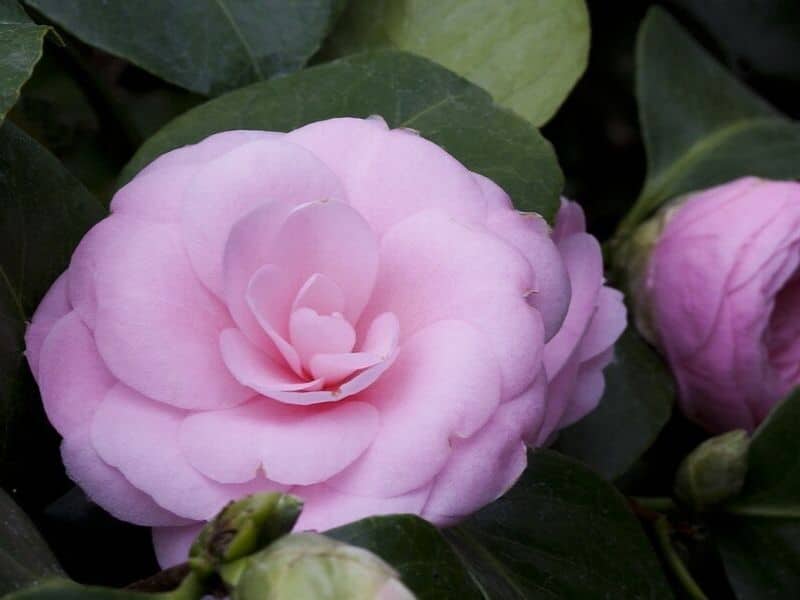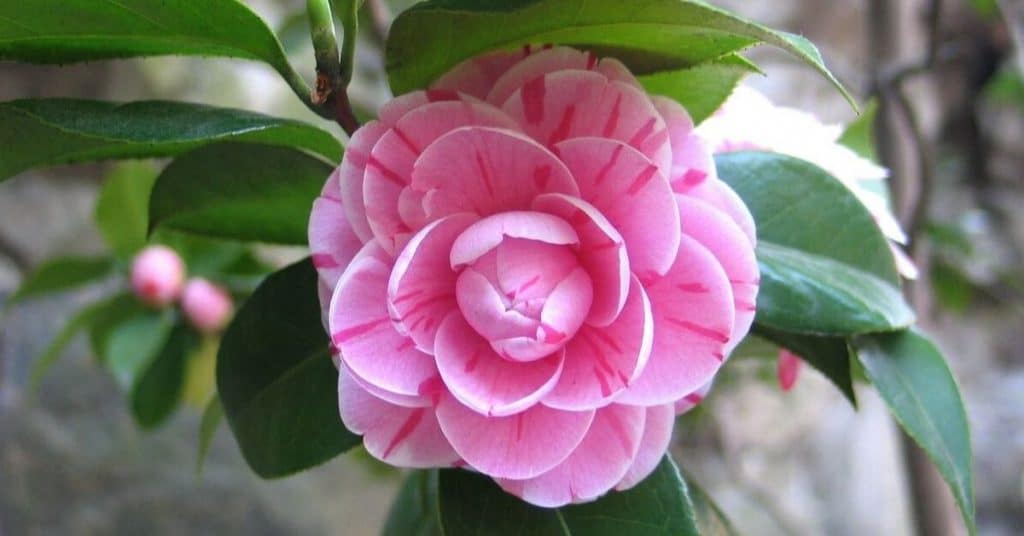Who wouldn’t turn their head to a garden filled with bright camellia blooms? May it be a screen or focal point to a landscape or cutflowers in a bouquet, the camellia, from its dark green foliage that can be turned into soothing and healing teas to its many-petaled flower that may mean purity or passion when given to a loved one, is bound to stand out.
Given the right care and growing conditions, the camellia plant will thrive and will definitely captivate one’s senses.
Camellia Origin
The camellia plant (Camellia spp) has been a staple in gardens not just in China, Japan, and Vietnam where it originated but in Europe and America where it has gained popularity as well (4).

This plant is named by the great Linnaeus after the Jesuit missionary, George Joseph Kamel or Camellia in recognition of his contributions to the field of pharmaceutical botany (3).
Camellia As An Ornamental Plant
Because of its success as an outdoor plant as well as its economic value, researchers and cultivators have shared a common interest and today, there are more than 200 identified species and over 40,000 cultivars of camellia.
Camellia japonica (Japanese Camellia), C. reticulata, and Camellia sasanqua Thunberg are among the species of great ornamental value. Sasanqua camellias bloom with delicate flowers, and their camellia sasanqua cultivars exhibit a wide range of colors and growth habits.
Most species have their own unique and desirable characteristics and are highly used in hybridization to produce more attractive and climate adaptive varieties; C. petelotii for the yellow color as opposed to the more common white, pink, and red, C. lutchuensis for fragrance, and C. oleifera for frost-hardiness (5).
Some common hybrids include: ‘Debbie’ Camellia with rich deep rose-pink flowers in both peony and anemone form on the same bush, Camellia x ‘Buttermint’ with beautiful pale buttery-yellow semi-double flowers that brighten up any shade garden and ‘Fairy Blush’ camellia, a moderate growing shrub that only grows 4-5 feet tall with dainty single white flowers each blushed pink around the edges with bright yellow stamens (6).
Camellia As A Culinary Plant
The camellia plant is not all about the looks, though. Belonging to the Theaceae or Tea Family, the camellia plant is historically grown for the production of tea.
The most common species used in making the world famous beverage is the Camellia sinensis var. sinensis and C. sinensis var. assamica which are widely distributed in China.
The young leaves and buds are harvested to be brewed into culinary and medicinal tea but aside from tea production, camellia plants are being utilized for oil extraction specifically, the seeds.
Another species, the Camellia oleifera has the longest history of being cultivated for oil production as well as C. drupifera and C. reticulate (1).
How to Grow Camellias
Nowadays, most camellias are cultivated for their ornamental value. Although many cultivars now exist which are adapted to different growing conditions, several factors still need to be considered in order to successfully grow this plant.
Light and Climate
Most of the camellia species are native to China and although primarily subtropical, many cultivars can be grown in temperate regions especially the C. japonica cultivars (4).
In areas with more severe climates, it is recommended to plant camellias in greenhouses especially during winter. Camellias grow in dappled shade usually provided by tree canopies. As with most species of flowers, camellias need good light to flower buds form, but the shade protects the flowers and leaves from extreme winds and rains (1).
Soil Type
Camellias thrive in well-draining, slightly alkaline soil. They prefer rich, loamy soil that retains soil moist but not waterlogged.
A mixture of organic matter, such as compost or peat moss, combined with sandy soil or perlite to improve drainage, creates an ideal growing medium for camellias.
Avoid heavy clay soils, which can lead to water stagnation and root rot. Additionally, applying a layer of mulch around the base of the plant helps retain moisture, regulate soil temperature, and suppress weed growth, further promoting the health and vigor of camellias.
Water Requirement
Watering camellias should be monitored. They do not tolerate drought so ample water supply must be provided during the leaf and shoot development period, usually in the early spring. In late winter, these potted plants are dormant and should be moderately watered (1).
Fertilizer Application
Fertilizers are also important to supply the necessary nutrients to the plant particularly nitrogen, phosphorus, potassium, iron, magnesium, sulphur, and calcium (2). Feeding camellias is crucial for their health and growth.
Fertilizer application on your plant in gardens should be 3 times a year and for potted camellias, application should be every four to six weeks.
Pests and Diseases
While generally problem-free, they can occasionally face disease issues. Here are some common Camellia diseases:
- Algal Leaf Spot: Caused by the algal pathogen Cephaleuros virescens, this disease appears as raised silvery-green, grayish-green, or tan spots on leaves and stems. It thrives in direct sunlight and moist conditions.
- Dieback and Canker: A serious issue caused by the fungus Glomerella cingulata, leading to yellowing and wilting of affected branches.
- Camellia Petal Blight: This disease affects camellia flowers, causing them to turn brown.
- Leaf Gall: Abnormal growths on leaves due to the fungus Exobasidium.
- Phyllosticta Spot: Characterized by circular, dark spots on leaves.
- Root Rot: A soil-borne disease that affects the roots.
- Viruses: Various viruses can impact camellias.
Planting and Maintenance
Camellias are considered tall shrubs which can reach up to nine meters in height. When growing them in gardens, it is also important to prune camellias to keep them at the recommended height, usually about two meters.
To propagate camellias, gardeners employ various methods, including air layering, semi-ripe cuttings, and the more successful grafting technique.
Additionally, it’s crucial to note that depending on the cultivar, camellias might start setting next year’s flower buds as early as mid-summer. Therefore, timely pruning is essential—consider doing it as soon as this year’s blooms have faded (5).
FAQs
Where do camellias grow best?
Camellias grow best in temperate climates with mild winters and moderate humidity. They thrive in well-drained, acidic soil and prefer locations with partial shade or filtered sunlight.
Do camellias like direct sun?
No, Camellias prefer partial shade to filtered sunlight. While they can tolerate some direct sun, especially in the morning or late afternoon, prolonged exposure to intense sunlight can scorch their leaves and cause sunburn.
How often do you water camellias?
Water camellias regularly, especially during dry periods or when newly planted. Keep the soil consistently moist but not waterlogged. Mulching around the base of the plant helps retain soil moisture and regulate soil temperature.
Are camellias best in pots or in the ground?
Camellias can thrive both in pots and in the ground, depending on the specific growing conditions and preferences of the gardener. When grown in pots, ensure they have adequate drainage and use a suitable acidic potting mix. In the ground, plant camellias in well-drained, acidic soil amended with organic matter.
Are camellias hard to maintain?
No, Camellias are generally low-maintenance plants, but they have specific requirements to thrive. They prefer acidic soil, regular watering, and protection from harsh sunlight and strong winds.
Up Next: Camellia Flower Meaning and Symbolism
References
(1) Bartholomew, Bruce. “The Chinese Species of Camellia in Cultivation.” Arnoldia, vol. 46, no. 1, 1986, pp. 2–15.
(2) Caser, M., et al. “Ethylene and the Postharvest Performance of Cut Camellia Flowering Branches.” Advances in Horticultural Science, vol. 29, no. 2/3, 2015, pp. 116–120.
(3) Cullum, Leo A. “Georg Joseph Kamel: Philippine Botanist, Physician, Pharmacist.” Philippine Studies, vol. 4, no. 2, 1956, pp. 319–339. JSTOR.
(4) (eFloras.org) Flora of China Vol. 12 Page 366, 367.
(5) Hakoda, Naotoshi, and Tran Ninh. “426. CAMELLIA FLAVA: Theaceae.” Curtis’s Botanical Magazine, vol. 18, no. 4, 2001, pp. 190–193.
(6) Le Strange, Michelle. “How to Grow Carefree Camellias.” Master Gardener Newspaper [University of California], 22 January 2009, p. A11.
Close
Photo credit: natmel&stux/pixabay.com







